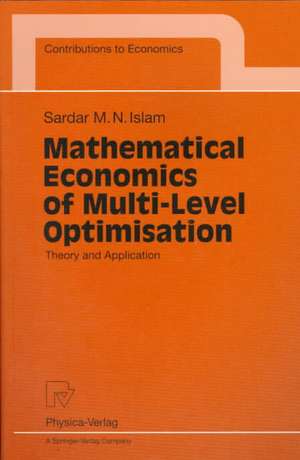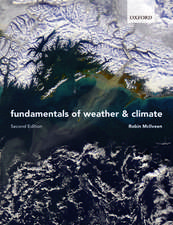Mathematical Economics of Multi-Level Optimisation: Theory and Application: Contributions to Economics
Autor Sardar M.N. Islamen Limba Engleză Paperback – 6 noi 1997
Din seria Contributions to Economics
- 18%
 Preț: 1109.92 lei
Preț: 1109.92 lei - 24%
 Preț: 657.06 lei
Preț: 657.06 lei - 15%
 Preț: 649.06 lei
Preț: 649.06 lei -
 Preț: 283.93 lei
Preț: 283.93 lei - 18%
 Preț: 1027.83 lei
Preț: 1027.83 lei -
 Preț: 90.83 lei
Preț: 90.83 lei - 18%
 Preț: 1001.81 lei
Preț: 1001.81 lei - 17%
 Preț: 361.01 lei
Preț: 361.01 lei -
 Preț: 307.42 lei
Preț: 307.42 lei - 15%
 Preț: 644.95 lei
Preț: 644.95 lei - 15%
 Preț: 638.24 lei
Preț: 638.24 lei -
 Preț: 394.29 lei
Preț: 394.29 lei - 15%
 Preț: 636.80 lei
Preț: 636.80 lei - 15%
 Preț: 637.78 lei
Preț: 637.78 lei - 18%
 Preț: 723.69 lei
Preț: 723.69 lei - 15%
 Preț: 635.47 lei
Preț: 635.47 lei - 15%
 Preț: 634.00 lei
Preț: 634.00 lei -
 Preț: 392.75 lei
Preț: 392.75 lei -
 Preț: 383.33 lei
Preț: 383.33 lei - 15%
 Preț: 637.28 lei
Preț: 637.28 lei - 15%
 Preț: 636.80 lei
Preț: 636.80 lei - 18%
 Preț: 950.96 lei
Preț: 950.96 lei - 15%
 Preț: 634.68 lei
Preț: 634.68 lei -
 Preț: 387.38 lei
Preț: 387.38 lei - 15%
 Preț: 647.27 lei
Preț: 647.27 lei - 15%
 Preț: 636.63 lei
Preț: 636.63 lei - 15%
 Preț: 639.73 lei
Preț: 639.73 lei -
 Preț: 385.62 lei
Preț: 385.62 lei - 15%
 Preț: 641.85 lei
Preț: 641.85 lei - 20%
 Preț: 649.60 lei
Preț: 649.60 lei - 15%
 Preț: 641.71 lei
Preț: 641.71 lei -
 Preț: 387.96 lei
Preț: 387.96 lei - 15%
 Preț: 645.47 lei
Preț: 645.47 lei -
 Preț: 385.08 lei
Preț: 385.08 lei - 15%
 Preț: 646.62 lei
Preț: 646.62 lei -
 Preț: 383.33 lei
Preț: 383.33 lei - 15%
 Preț: 638.43 lei
Preț: 638.43 lei -
 Preț: 381.21 lei
Preț: 381.21 lei - 15%
 Preț: 642.51 lei
Preț: 642.51 lei - 15%
 Preț: 637.78 lei
Preț: 637.78 lei - 15%
 Preț: 641.71 lei
Preț: 641.71 lei -
 Preț: 384.70 lei
Preț: 384.70 lei -
 Preț: 379.86 lei
Preț: 379.86 lei -
 Preț: 378.34 lei
Preț: 378.34 lei -
 Preț: 384.70 lei
Preț: 384.70 lei -
 Preț: 388.52 lei
Preț: 388.52 lei - 15%
 Preț: 641.71 lei
Preț: 641.71 lei -
 Preț: 381.00 lei
Preț: 381.00 lei - 15%
 Preț: 644.95 lei
Preț: 644.95 lei -
 Preț: 386.00 lei
Preț: 386.00 lei
Preț: 640.06 lei
Preț vechi: 753.01 lei
-15% Nou
Puncte Express: 960
Preț estimativ în valută:
122.49€ • 126.37$ • 103.67£
122.49€ • 126.37$ • 103.67£
Carte tipărită la comandă
Livrare economică 04-18 martie
Preluare comenzi: 021 569.72.76
Specificații
ISBN-13: 9783790810509
ISBN-10: 3790810509
Pagini: 304
Ilustrații: XVIII, 284 p.
Dimensiuni: 152 x 229 x 16 mm
Greutate: 0.41 kg
Ediția:Softcover reprint of the original 1st ed. 1998
Editura: Physica-Verlag HD
Colecția Physica
Seria Contributions to Economics
Locul publicării:Heidelberg, Germany
ISBN-10: 3790810509
Pagini: 304
Ilustrații: XVIII, 284 p.
Dimensiuni: 152 x 229 x 16 mm
Greutate: 0.41 kg
Ediția:Softcover reprint of the original 1st ed. 1998
Editura: Physica-Verlag HD
Colecția Physica
Seria Contributions to Economics
Locul publicării:Heidelberg, Germany
Public țintă
ResearchCuprins
1 Introduction.- 1.1 Introduction.- 1.2 The MLO Approach.- 1.3 Energy Planning: Multi-Level Energy Planning System.- 1.4 Objectives of the Book.- 1.5 Plan of the Book.- 2 Multi-Level Optimisation.- 2.1 Introduction.- 2.2 Definitions.- 2.3 Existence and Uniqueness Problem.- 2.4 Current State of MLP Developments.- 2.5 Critical Evaluation and Directions for Further Research.- 3 Multi-Level Programming.- 3.1 Introduction.- 3.2 Parametric Programming Search Algorithm.- 3.3 MLP Solution by the PPS Algorithm.- 3.4 An Alternative Specification of an MLP Model.- 3.5 Some Issues in Using the PPS Algorithm.- 3.6 A Summary of the Algorithmic Steps.- 3.7 Software.- 3.8 Use of the PPS Algorithm in Different Types of Policy Studies.- 3.9 Application of the PPS Algorithm to Different Types of MLP.- 3.10 Advantages and Limitations of the PPS Algorithm.- 4 A Multi-Level Optimisation Approach to Multi-Level Energy Planning.- 4.1 Introduction.- 4.2 Model Evaluation Criteria.- 4.3 Existing Energy Sector Optimisation Models.- 4.4 Evaluation of Existing Energy Modelling Approaches.- 4.5 An Alternative Modelling Approach: Multi-Level Optimisation of Energy Systems and Energy Policy.- 4.6 A Multi-Level Optimisation Energy Model.- 4.7 Some Features of the Present Energy Planning Study/Approach.- 4.8 Characteristics of Multi-Level Decision Making: Some Analytical Results.- 5 A Multi-Level Optimisation Energy Planning Model for Australia.- 5.1 Introduction.- 5.2 The Australian Energy Sector the Context for Energy Planning and Modelling in Australia.- 5.3 The Australian Energy Planning Model (AEPSOM): Some Preliminaries.- 5.4 AEPSOM: Model Specification.- 5.5 AEPSOM Policy Variables.- 5.6 Data.- 5.7 Summary.- 6 The Results of the Australian Energy Planning Model.- 6.1 Introduction.- 6.2 AEPSOM Solutions and Output.- 6.3 Presentation and Discussion of the AEPSOM Results.- 6.4 Sensitivity Analysis.- 6.5 Reliability of the Results: Model Validation.- 6.6 Conclusion.- 7 An Australian Optimum Multi-Level Energy Plan.- 7.1 Introduction.- 7.2 An Optimum Energy System Plan.- 7.3 Optimum Energy Policies.- 7.4 An Energy Policy Plan for Australia.- 7.5 Conclusion.- 8 Major Findings: Summary, Areas for Further Research, and Conclusions.- 8.1 Summary and Overview.- 8.2 Conclusions.- Appendix A: AEPSOM Data: Sources and Methods of Estimation.- A. 1 Discussion of the General Aspects.- A.2 Data for AEPSOM.- A.2.1 The Behavioural Constraints.- A.3 Methods and Principles of Estimation and/or Aggregation of Data in AEPSOM.- Appendix B: AEPSOM: 1989-90.- B. 1 AEPSOM: 1989-90 Model Specification.- B. 1.1 Preliminaries.- B.1.2 Specification of AEPSOM.- B.2 Data for AEPSOM: 1989-90.- B.2.1 The Behavioural Constraints.- Appendix C: A Complete List of AEPSOM Solutions.- C. 1 Model Specification and Solutions.- C.2 Selection of the Appropriate Model Specification and Solution.- C.2.1 The Effects of the Units.- C.3 The Policy Objective Function.- References.
Textul de pe ultima copertă
Since there exists a multi-level policy making system in the market economies, choices of decision makers at different levels should be considered explicitly in the formulation of sectoral plans and policies. To support the hypothesis, a theoretical energy planning approach is developed within the framework of the theory of economic policy planning, policy systems analysis and multi-level programming. The Parametric Programming Search Algorithm has been developed. On the basis of this theoretical model, an Australian Energy Policy System Optimisation Model (AEPSOM) has been devloped and is used to formulate an Australian multi-level energy plan. The results of this study suggest that a reformulation of existing Australian energy policies is needed. This study overcomes the limitations of existing single level optimisation models, and therefore makes a significant contribution to the principles and methods for economic modelling in a market economy.













